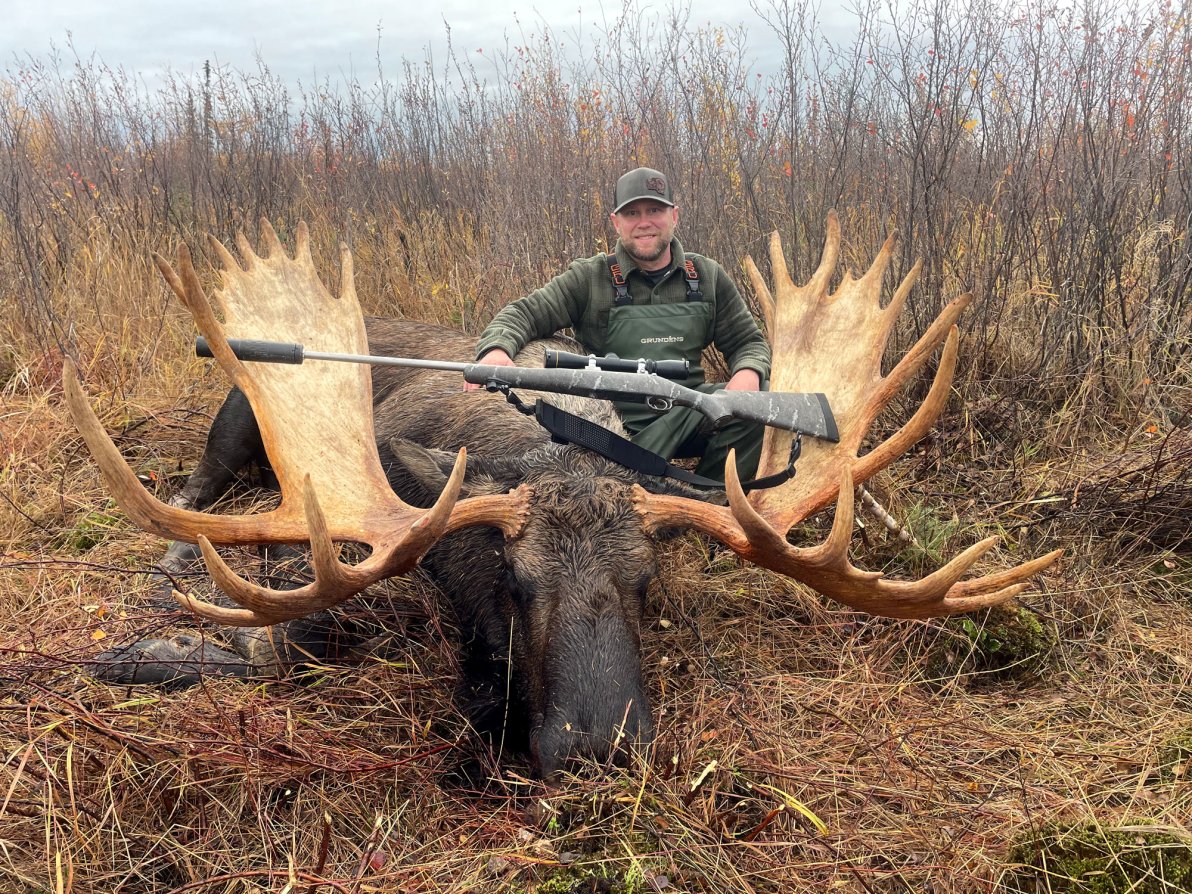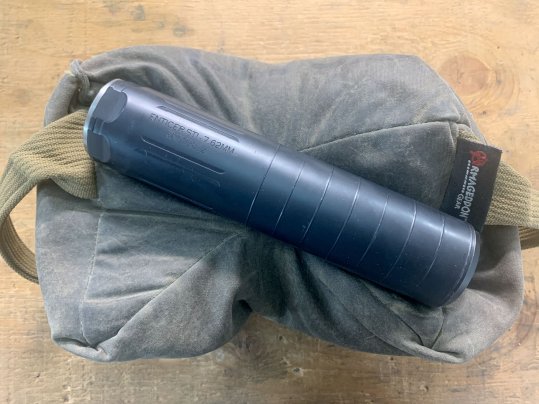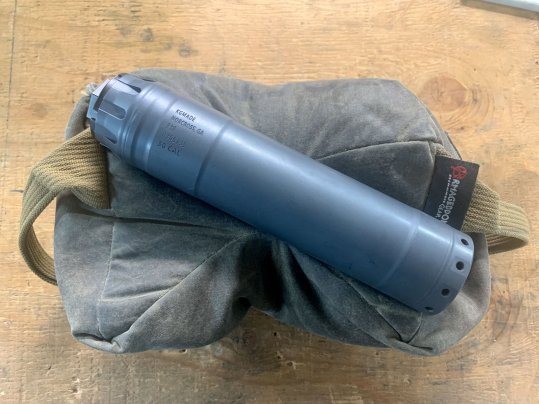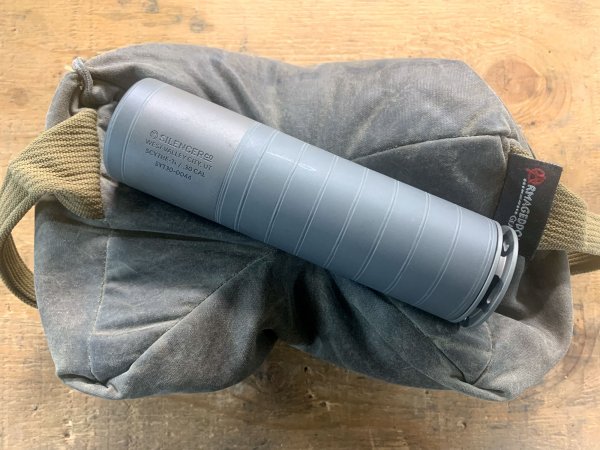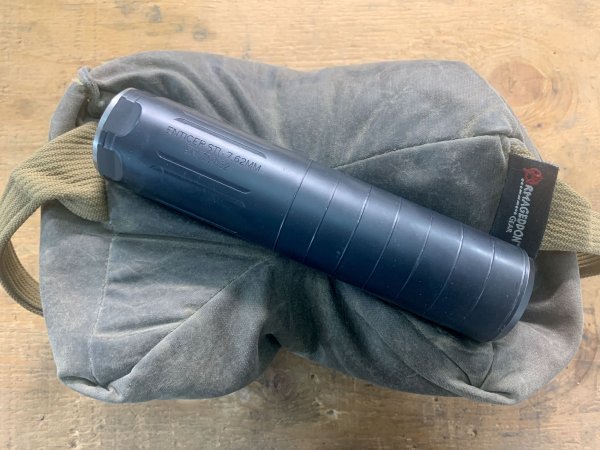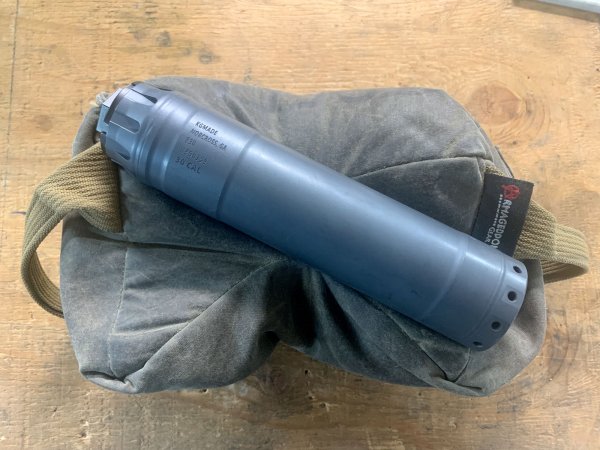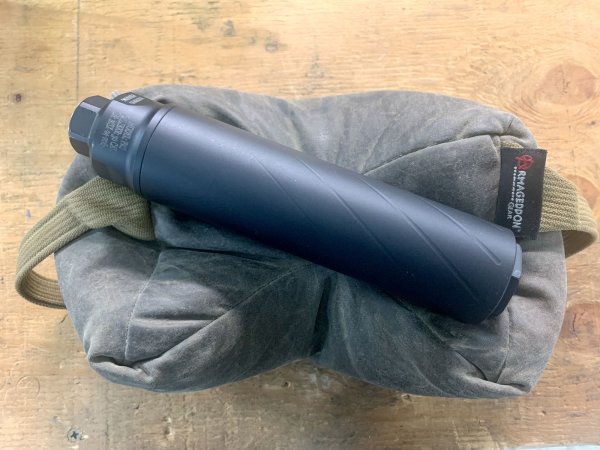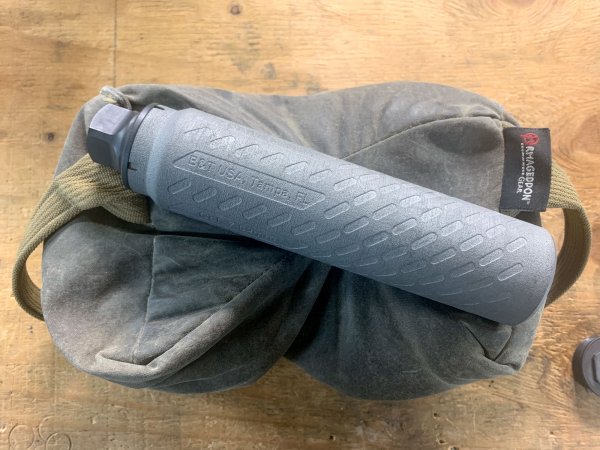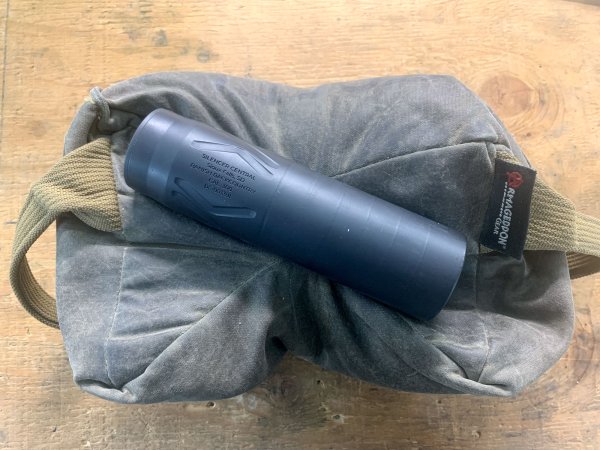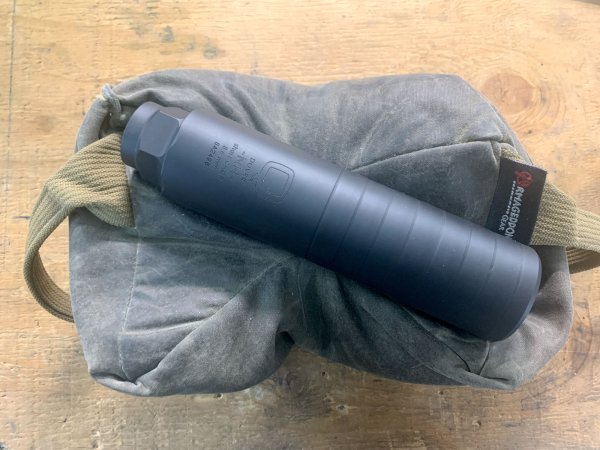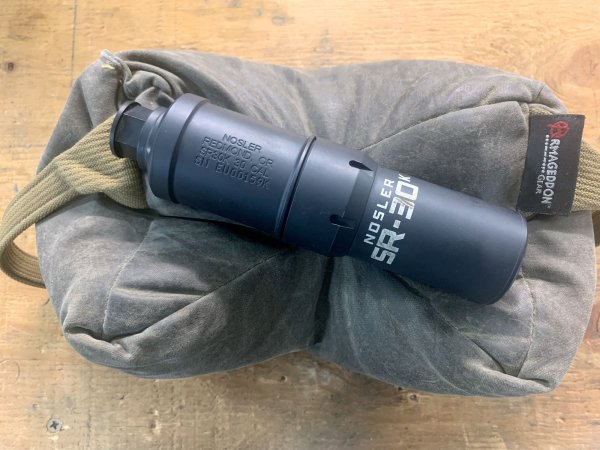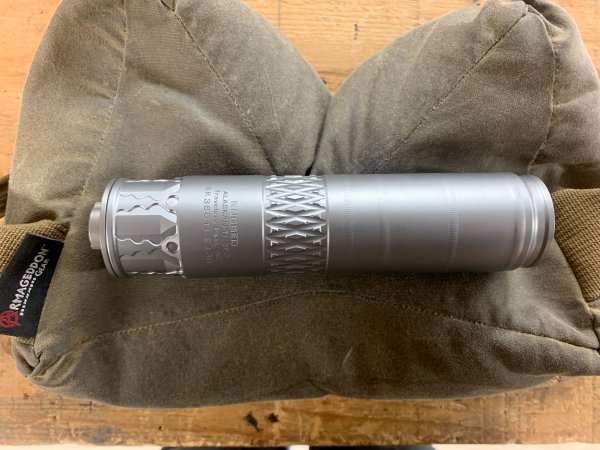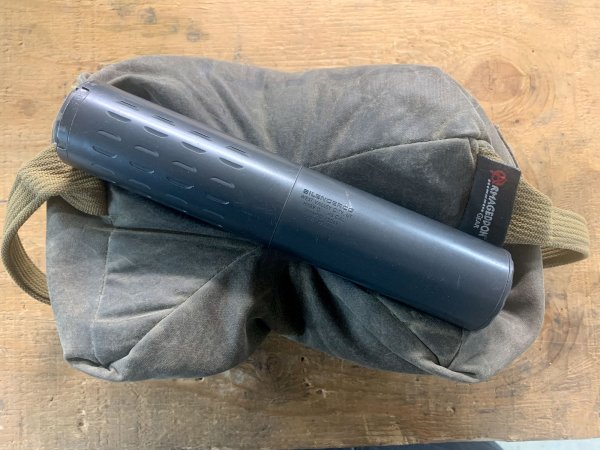We may earn revenue from the products available on this page and participate in affiliate programs. Learn More ›
What’s the best suppressor for me? That’s a question more hunters are asking every day. I bought my first suppressor back in 2009 when it required hard copies of fingerprints, passport photos, and paperwork signed off by my local law enforcement. And then there was the 9 to 12 month wait for ATF approval. In those days, most hunters weren’t aware that suppressors were legal to buy. On top of that, they weren’t even legal to use for hunting in a number of states, and were considered little more than a novelty by the American hunter. That’s no longer the case.
Suppressors, or silencers (the terms are essentially interchangeable) are more popular than ever. The eForms system, and retailers who have built business around using it, have made the paperwork a breeze. Even better, within the last year, wait times have dropped to a matter of days. The booming market has also driven innovation, and suppressors are now made from lightweight materials like titanium. Picking the best suppressor for your hunting rifle can be a daunting task, so we’ve put together this guide to help you make an informed choice.
- Top Pick: Silencerco Scythe Ti
- Best Value: Diligent Defense Enticer S-TI
- Best for Magnums: KGM R30
- Best Budget: Maxim Defense PRS 30
- B&T SRBS 7.62 Ti
- Silencer Central Banish Backcountry
- Q Short Chop
- Nosler SR-30K
- Rugged Alaskan 360 Ti
- Silencerco Hybrid 46
Why Should You Consider a Suppressor for Your Hunting Rifle?
Despite being well-established for hunting in places such as the UK, Scandinavia, mainland Europe, New Zealand, and South Africa, suppressors or silencers have been used rarely by American hunters since their invention. So why would we change now? What benefits do suppressors offer hunters?
You might think that the reduction in sound will help keep game more calm and result in better follow-up shot opportunities. After all, isn’t the whole point of using a suppressor to quiet the audible report of your rifle? Yes, but there’s more to it.
Read Next: How to Buy a Suppressor
Not only will suppressor on your hunting rifle will reduce the noise, but it will also reduce recoil and virtually eliminate muzzle blast. This is great for your ears, but it’s even better for your shooting. Whether you’re young, old, a new hunter, or an experienced woodsman, you will shoot better with a suppressor. Once you become accustomed to it, you’ll never want to shoot or hunt without one. This phenomenon is backed by our experience at the annual gun test. We rarely used suppressors in the past but, in 2024, every single rifle that was threaded had a can on it. We won’t be switching back. I can’t say I’ve met a single person who’s said “no thanks” after getting some time behind a silencer.

Potential Drawbacks to a Suppressor on Your Hunting Rifle
Despite buying my first suppressor about 15 years ago, I didn’t use them for most of my big game hunting. The two biggest reasons were the additional weight and that most of my rifle barrels weren’t threaded. The expense is also a drawback (more on this in a minute).
Weight is a primary consideration. My first can measured 9 inches long and weighed about two pounds. That was fine for a predator rifle, but I wasn’t willing to pack that around the mountains. Weight is a big concern for many hunters when considering a suppressor. If it makes the rifle too heavy or unwieldy, it’s just not worth the trouble. Fortunately, there are now many options for lightweight suppressors that any hunter will find appealing.
Until recently, a threaded barrel was less common on hunting rifles. Many hunters still use rifles that don’t have threaded barrels and sometimes you might just not want to thread your favorite old rifle. On new rifles, however, a threaded muzzle is becoming the standard — and muzzle-threading services are more available. In fact, suppressors have become so influential in the market that many rifles are being offered with shorter barrels specifically to accommodate suppressors.
The Best Suppressor for Hunting: Making Our Picks
In this guide, I’m going to present my findings from each of the listed suppressors after shooting and hunting with them. That way, you can pick what will work best for you. I’m not claiming that any of these suppressors are the undisputed champ of the market. They each have their pros and cons. There are also many high-quality suppressors that I simply haven’t had the chance to test yet — and we don’t vouch for stuff we haven’t used.
Unlike some of our other in-depth tests, you may notice that there won’t be any hard data measurement presented here. Contrary to what you might see on YouTube, testing suppressors properly and objectively for metrics like sound, flash, and recoil reduction require more than an accelerometer and decibel meter. More importantly, those characteristics are somewhat variable and dependent on factors like barrel length and ammunition type.
So consider this a buyer’s guide. It’s more important for you — the hunter and potential customer — to sift through the different attachment systems, trade offs of different materials, and look at cost versus benefit, than it is to know that one suppressor is 2 dB quieter than the other under certain conditions. All these suppressors are just metal tubes with baffles. All of them reduce sound, recoil, and muzzle blast. The most meaningful differences are in the other details.

Reviews and Recommendations
Here are some of the best suppressors to consider for your hunting rifle.
Top Pick: Silencerco Scythe Ti
Pros
- Very light
- Standard HUB accessory compatible
- Endcap brake reduces recoil dramatically
- Excellent for a wide range of cartridges
- User-friendly disassembly
- Lifetime warranty
Cons
- Might not be best choice for some shorter-barreled magnums
Specs
- Caliber Rating: Up to .308 inches
- Cartridge Rating: Up to .300 RUM, with no barrel length restrictions
- Material: Titanium
- Length (with direct thread mount): 6.125 inches
- Diameter: 1.730 inches
- Weight (measured with factory-direct thread mount): 8.6 ounces
- Front cap: Interchangeable, includes brake endcap
- Rear: 1.375 x 24 standard HUB threads
- Price: $1,175
Key Features
- Ultralight welded titanium construction
- Brake endcap greatly reduces recoil
- Excellent titanium direct thread adapter
- Can be used with a variety of HUB-compatible mounts
- Tool included to aid removal of adapters if excessively fouled
The Silencerco Scythe Ti is one of the hottest suppressors of 2024. This titanium can is one of the lightest available, and its front cap brake makes a tangible difference in recoil reduction compared to other suppressors of similar size and weight. The Scythe has eight welded baffles and a built-in removal aid at the front that engages an included tool. As with many suppressors, direct-thread and quick-detach adapters can become stuck in the back of the can due to fouling. Having the included tools to remove and install these parts without damaging anything is a big plus.
Because the Scythe uses the industry standard 1.375 x 34 HUB threads at the back end of the blast chamber, it can be used with both Silencerco and other brands of HUB accessories. The can ships with a standard 5/8×24 direct-thread mount, and it’s one of my favorite titanium DT mounts. It’s easily installed and removed with Silencerco’s included tool and, when used on other HUB-compatible suppressors, it can help decrease their weight and overall length too.

The Scythe Ti is a great option for anyone who shoots a variety of .30-and-smaller calibers. Even with the .308-caliber endcap it’s perfectly suitable for .223, and even works well with .17 Hornet. An oversized endcap shouldn’t concern you. I found this to be a great can for 6.5 Creedmoor rifles and used it on a 6mm Creedmoor in my first NRL Hunter match.
What I would be cautious about, however, is using the Scythe Ti with large .30-cal magnums — especially if they have shorter barrels. The Scythe is rated for .300 RUM, specifically with no barrel length restrictions, but I blew mine up after about 15 shots on a 20-inch .300 PRC (I had fired several thousand shots from smaller cartridges through it as well). The high pressures inside the can caused a weld failure and the front end of the suppressor launched 50 yards downrange like an Apollo rocket booster. Working through Silencerco’s customer service was painless and I had my repaired suppressor back in a week. I know of this happening to several other Scythes (as well as other brands), and it just highlights a potential weak point of ultra-thin welded titanium. If you’re shopping specifically for a can for your large magnum, it’s something to consider.
Best Value: Diligent Defense Enticer S-TI
Pros
- Very light
- HUB-compatible
- Interchangeable front caps use T60 Torx wrench, compatible with Dead Air front caps
- Wrench flats on both suppressor and DT adapter
- Lifetime warranty
- Excellent value
Cons
- Availability can be limited
Specs
- Caliber Rating: Up to .308 inches
- Cartridge Rating: Up to .300 RUM (24-inch barrel), .300 Win. Mag. (20-inch barrel)
- Material: Titanium
- Length (with direct thread mount): 7 inches
- Diameter: 1.62 inches
- Weight (measured with factory direct thread mount): 9.1 ounces
- Front cap: Interchangeable
- Rear: 1.375 x 24 standard HUB threads
- Price: $765
Key Features
- Ultralight welded titanium construction
- Interchangeable front caps
- Titanium DT adapter with wrench flats
- Can be used with a variety of HUB-compatible mounts

The Enticer S-TI from Diligent Defense is a lightweight titanium suppressor that is one of the best values I’ve seen. Only about one ounce heavier than the lightest cans on the market, it’s nearly shocking to see it at such an affordable price. I’ve been shooting mine for months now, and I can’t find a damn thing wrong with it. I even used it this past September on my .22 ARC while hunting moose.
This suppressor has a blast chamber that’s long enough to accommodate some over-brake HUB adapters, but it comes with a titanium DT adapter with 13/16-inch wrench flats The body of the suppressor also has wrench flats at the rear for removing a fouled-in adapter. There are seven baffles, and this can has a noticeable quiet tone compared to many others that I have.
As mentioned before, front caps aren’t something I spend too much time worrying about — they don’t seem to make a noticeable difference with noise, but I did alternate back and forth between a .308- caliber and 6.5mm end cap. The Enticer S-TI is compatible with Dead Air brand endcaps too, so if you want something smaller than .308, it’s an option. The DDC endcaps thread into the end of the suppressor with the included T60 Torx wrench.
Diligent Defense lists some specific guidelines for caliber and barrel-length ratings, as well as noting that it’s not really a full-auto-rated can. The Enticer S-TI comes with a lifetime warranty for responsible use but, as with the Scythe Ti, I think that pushing the limits has the potential to result in some failures. As long as you’re keeping that in mind, I think that this suppressor offers just about everything the all-around hunter needs, and at a great price.
Best for Magnums: KGM R30
Pros
- Light
- HUB-compatible
- Adjustable-flow front cap
- Spanner wrench grooves on can, wrench flats on DT adapter
- Designed for precision shooting
- Heavy-duty construction
Cons
- Not as light as some other titanium cans
Specs
- Caliber Rating: Up to .308 inches
- Cartridge Rating: up to 300 PRC, .300 Norma Mag.
- Material: Titanium
- Length (with direct thread mount): 7.625 inches
- Diameter: 1.75 inches
- Weight (measured with factory direct thread mount): 15.2 ounces
- Front cap: Sealed, with threaded adjustment ports
- Rear: 1.375 x 24 standard HUB threads
- Price: $1,000
Key Features
- Lightweight but heavy-duty welded titanium construction
- Baffles designed for non-disruptive gas flow
- Threaded front cap ports can be plugged to tune gas flow
- Can be used with a variety of HUB-compatible mounts
- Heavy-duty construction to handle magnum cartridges
If you’re looking for a suppressor specifically for a .30-caliber magnum, the KGM R30 is an excellent choice. Many of the ultralight suppressors weighing between 8 and 12 ounces are rated for magnums and can offer a lifetime of reliable service, but the R30 is what I’ve been most impressed with for my .300 Win. Mag. and 20-inch-barreled .300 PRC. For a small increase in weight and overall length, the R30 provides a noticeably smoother shooting experience and reduced recoil compared to the others in this lineup. Shooting that short-barreled .300 PRC is riding the lightning, but the R30 cuts down recoil to about .243/6mm Creedmoor levels. On the range, I was able to recover my sight picture and spot impacts regularly as close as 400 yards.

The KGM R30 is a sealed, welded titanium suppressor and, while light, it’s designed specifically to handle magnum cartridges in precision rifles. The R30 has a relatively complex baffle design, which is intended to regulate gas flow in a way that is minimally disruptive to the bullet’s point of impact and doesn’t create too much backpressure in semi-autos. The Adjustable Port End Cap isn’t removable, but features 10 threaded ports that act as a brake to further reduce recoil. The R30 comes with set screws that can be installed in some or all of the holes to regulate the flow of gas to your liking. The body or tube of the suppressor appears to be thicker, or possibly multi-layered. Unlike some of the ultralight cans, you cannot visibly see the baffle welds on the exterior.
The rear of the can, like many others, features a 1.375×24 HUB-pattern thread to accept standardized adapters, but the factory KGM titanium DT adapters are heavy-duty and feature wrench flats on the inside as well — to remove a stuck-on adapter from a barrel if necessary. If you like the features of the R30, but don’t need its magnum-taming capabilities, the KGM R30K is another excellent option. It’s got everything the R30 has, but in a shorter 6-inch, 11.6-ounce package. I hunted with the R30K this spring, and it’s a great choice too.
Best Budget Suppressor: Maxim Defense PRS 30
Pros
- Light
- User-serviceable design
- Wrench flats for disassembly
- Excellent performance for the weight
- Great Value
Cons
- Aluminum isn’t quite as durable as other materials
Specs
- Caliber Rating: Up to .308 inches
- Cartridge Rating: Up to .30-Cal Magnums
- Material: Aluminum (with titanium thread insert)
- Length: 7.875 inches
- Diameter: 1.750 inches
- Weight (measured with factory direct thread mount): 11.2 ounces
- Front cap: Integrated as part of baffle core
- Rear: titanium 5/8×24 threaded insert
- Price: $626
Key Features
- Three-part weldless design
- Easy disassembly, user-serviceable “MonoKore” baffle stack
- Titanium thread insert is durable and resists galling or cross-threading
- Rated for slower-paced fire like a PRS or hunting rifle
- Large wrench/socket flats for disassembly

Suppressors, especially with the required tax stamp, are expensive. But if you’re looking for a lightweight can for your hunting rifle that won’t break the bank, the Maxim Defense PRS 30 is a smart option. At about $600 for the can, it’s as cheap as you will find any decent suppressor — and most of those are very heavy. This one is only a couple ounces heavier than the lightest titanium offerings.
The PRS 30 gets its weight and cost savings by being made of aluminum. Because it used to take around a year for approval, and it’s not as durable as materials like stainless steel, inconel, or titanium, aluminum has never been a popular material for centerfire rifle suppressors in the United States. In countries where suppressors are an over-the-counter purchase aluminum is much more common.
Aluminum is light, and the PRS 30 is a nice option for a hunting suppressor. It’s a weldless design, featuring three main components: the rear cap with a threaded titanium insert, the internal baffle stack and front cap, and the outer tube. These are easy to disassemble, and the user manual recommends it for regular cleaning and maintenance. Disassembly isn’t required, but as any suppressor becomes more fouled, it becomes increasingly difficult to take apart. The aluminum socket and wrench flats can be rounded or damaged much more easily than steel or titanium. Each time you do take it apart, the built-in carbon cutter peels excess fouling from the inside of the tube, and you can easily clean carbon buildup. Over time, many suppressors will accumulate several ounces of carbon in the baffle system, and it’s not a bad idea to prevent that buildup if you can.
The PRS 30 is a simple can that will do just about anything you need a hunting suppressor to do. There isn’t much published information on explicit caliber ratings, but it’s a robust design and the engineers at Maxim say it’s suitable for just about any .30-caliber or smaller cartridge. Personally, I’d be cautious with 20-inch-or-less-barreled magnums. With those, you’re likely to see a lot more baffle erosion. Aluminum doesn’t resist extreme heat as well as some other materials either, however, it’s perfectly suited for hunting or PRS competitions.
B&T SRBS 7.62 Ti
Pros
- Very Light
- Standard HUB accessory compatible
- 3D-printed design eliminates welds and reduces weak points
- Excellent for a wide range of cartridges
- Low-backpressure helps with semi-autos
- OK for shorter barrels and rapid fire
Cons
- Expensive
Specs
- Caliber Rating: Up to .308 inches
- Cartridge Rating: Up to .300 PRC
- Material: Titanium
- Length (with factory direct thread mount): 7.5 inches
- Diameter: 1.75 inches
- Weight (measured with factory direct thread mount): 11.2 ounces
- Front cap: Sealed, with flow-through vents
- Rear: 1.375 x 24 standard HUB threads
- Price: $1,350
Key Features
- Ultralight 3D-printed titanium construction
- Flow-through baffle design reduces backpressure in semi-autos
- Can be used with Rotex/Surefire brake mount or direct thread adapter
- Functional both for ultralight hunting rifle and heavy semi- or full-auto use
- Spanner Wrench notches printed into the design
If there is an ultimate lightweight suppressor, it might just be the SRBS 7.62 Ti from B&T. You might know them for their integrally suppressed sub-guns or discreet bolt-action .300 BLK rifles, but B&T makes some kick-ass suppressors too. The Slimline Reduced Backpressure System (SRBS) cans provide the lightweight benefits of titanium, while minimizing some of its drawbacks.
The entire suppressor is 3D printed in titanium, which does two things. First, it eliminates the potential weak points of welds (where my previously-mentioned can failed on a .300 PRC). Second, the 3D printing process allows easier construction of intricate vented baffles to regulate gas flow. This reduces backpressure and overgassing in semi-autos, but also reduces risk of failure in shorter-barreled magnum cartridges, since the pressure load on those rear baffles is reduced.

With the B&T direct-thread adapter, the SRBS 7.62 Ti suppressor weighs 11.2 ounces, but that adapter is unnecessarily heavy-duty for hunting rifle use. When paired with the Silencerco titanium HUB DT adapter, it’s only 9.2 ounces — just a few ounces heavier than the Scythe Ti. The lighter, flush-fitting mount also reduces the overall length by three quarters of an inch to 6.75 inches. I shot this suppressor on 6.5 CM and .308 rifles, as well as my 20-inch .300 PRC. The straight-vented flow-through design doesn’t reduce recoil as much as the endcap brakes on the Scythe Ti on smaller stuff and the KGM R30 on the .300, but it was quite manageable. This would be my choice if I wanted to use an ultralight can on a big magnum or wanted one premium can to cover all bases.
Silencer Central Banish Backcountry
Pros
- Very Light
- One of the most compact options available
- Standard HUB accessory compatible
- Good for a wide range of cartridges
Cons
- Doesn’t reduce recoil as well as several other cans in its weight class
- Factory DT mount has very narrow wrench flats, none on can
Specs
- Caliber Rating: Up to .308 inches
- Cartirdge Rating: Up to .300 RUM
- Material: Titanium
- Length (with direct thread mount): 5.625 inches
- Diameter: 1.625 inches
- Weight (measured with factory direct thread mount): 9.5 ounces
- Front cap: Sealed
- Rear: 1.375 x 24 standard HUB threads
- Price: $1,100
Key Features
- Ultralight titanium construction
- Most compact can in its class
- HUB adapter allows use with other direct thread mounts
- Included direct thread adapter has narrow wrench flats

The Banish Backcountry is heavily marketed as the best suppressor for your mountain rifle. While not everyone will reach that conclusion, it’s certainly a worthy contender. The Banish Backcountry is a compact but robustly-constructed titanium can. In fact, it’s the most compact hunting rifle suppressor I have used — considering overall length with adapter. More impressive, it’s rated for calibers up to .300 RUM.
The Banish Backcountry seems to be thicker walled than the slightly larger, but one ounce lighter, Scythe Ti. With the factory direct thread adapter, mine weighed 9.5 ounces. It has a simple six-baffle stack, with vents through the rear baffle to allow some gas flow. Sound reduction (which is variable) isn’t obviously different from similar cans in its class, but it’s not as effective at softening the recoil impulse. Compared to higher-volume suppressors, recoil is noticeably sharper on lightweight rifles in 6.5 CM like the Browning X-Bolt 2. That disparity increases with the intensity of the cartridge. I think this is ideal for a hunter who shoots a lot of smaller .22-cal and 6mm cartridges, but also wants to use it up to the .30/06-class. It was delightful to shoot on the wood-stocked Weatherby 307 in .30/06.
Simple is good for a hunting suppressor, but I do wish that the Banish Backcountry had wrench flats or spanner notches on the can itself. Removing a stuck adapter can be quite challenging with no safe way to apply torque to the can. I have resorted to using a rubber strap oil filter wrench at times. It would also help to have wider wrench flats on the direct thread mount. They are pretty narrow, and it can be difficult to remove the direct thread mount if the threads are heavily fouled. If you want to swap between 1/2×28 and 5/8×24 mounts, being able to remove them without damaging anything is important. I’d recommend using the Silencerco Bravo titanium direct thread mounts.
Q Short Chop
Pros
- Light and compact for a .338 can
- Ultra-durable steel
- Very affordable
- Good option for many calibers .338 or smaller
Cons
- Only mounts over proprietary muzzle devices
Specs
- Caliber Rating: Up to 8.6mm/.338 inches
- Cartridge Rating: Up to .338 Win. Mag.
- Material: Steel
- Length: 7.167 inches
- Diameter: 1.75 inches
- Weight (measured with required muzzle brake): 15.4 ounces
- Front cap: Sealed
- Rear: Quick-attach, thread over muzzle device
- Price: $800
Key Features
- Lightweight build
- Deep-drawn steel is thin without sacrificing strength
- Compact and suitable for many hunting applications
- Sealed design is simple and robust
Cans are plentiful if you’re shooting .30 caliber or smaller, but it’s tougher to find the best suppressor if you’re shooting a larger-diameter bullet. When you bump up to .338 caliber and larger, suppressors tend to get bigger — much bigger. The Q Short Chop is an exception to that. Developed specifically for hunting use with the 8.6 BLK, it’s a surprisingly versatile can. On normal-length barrels, it’s fine for cartridges like .338 and .300 Win. Mag., and ideal for thumpers like the .338/06 and .338 Federal. I’ve been using it on my .338 Win. Mag. Ruger Guide Gun, and it’s still unobtrusive on my Q Mini Fix in 6mm ARC.
For a steel can, the Short Chop is astonishingly light at 12.2 ounces (without including muzzle device weight). Even with the required muzzle device, it’s only a bit heavier than many of the other cans on this list. Q uses a deep-draw process to create a thin, light, and strong suppressor that’s more affordable than just about any other .338 can.

The 1.75-inch-diameter tube has similar volume as many .308-caliber cans, which are most often 1.75 inches in diameter too. It’s a sealed suppressor, but I can see that the baffles have vents to allow some gas movement between chambers. All this makes it quite pleasant to use. I like that the over-brake design doesn’t result in any significant length added to the system. Even on the end of a normal-length rifle, the can is unobtrusive.
The only versatility drawback of the Short Chop is its proprietary mounting system, which uses Q muzzle devices. This isn’t a bad thing, but it doesn’t allow you to use standardized direct thread adapters. Fortunately, Q’s Cherry Bomb brakes and other muzzle accessories are easy to install and remove, so a couple of them would cover your bases in a pinch. This is probably the best all-around option I’ve used for .338 and smaller.
Nosler SR-30K
Pros
- Very Lightweight
- Compact
- Replaceable baffle stack
- Strong, non-welded construction
- Affordable
Cons
- Added length from direct thread mount or brake negates some of the size advantages
- Noticeably a bit louder than larger cans
Specs
- Caliber Rating: Up to .308 inches
- Cartridge Rating: Up to .30-378 Wby. (over 18-inch barrels)
- Material: Aluminum and titanium
- Length (with direct thread mount): 6.3 inches
- Diameter: 1.74 inches
- Weight (measured with factory direct thread mount): 8.3 ounces
- Front cap: Sealed
- Rear: Proprietary over-brake or direct thread mounting
- Price: $729
Key Features
- Monolithic baffle stack
- Threaded construction — no welds
- Can thread directly over Nosler brakes
- Left-hand threaded
- Large blast chamber, stepped down to baffle stack

Many companies are making “K” versions of some of their most popular cans. According to SilencerShop, the “K” nomenclature is derived from “Kurtz,” the German term for “short.” This is similar to how the .380 ACP is also known as the 9mm Kurtz. Short “K” cans like the previously mentioned KGM R30K and, of course, the Nosler SR-30K offer some distinct advantages compared to their full-size compadres, and they make a few concessions too. To a hunter, the compact size and light weight is a tangible benefit. Paired with a shorter-barreled rifle, a can like the Nosler SR-30K offers the hunter excellent sound and blast suppression without creating an unwieldy package.
The SR-30K is based on the design of some of Nosler’s larger SR-30 cans. It’s a weldless can made of both aluminum and titanium, with components that are threaded together and held in place by a large jam nut on the suppressor’s exterior. This results in strong construction while allowing the use of less expensive materials like aluminum. Like the full-sized SR-30 suppressors, the SR-30K has a large blast chamber that is designed to fit over and thread onto Nosler’s proprietary muzzle brakes. In front of that is a short monolithic baffle stack that is replaceable.
Most hunters will probably opt to use the direct thread mount included with the suppressor. Nosler recommends installing the mount with the included Rockset thread locker because the blast chamber has a left-hand thread. If you’re not careful, you can inadvertently loosen the mount while threading it onto the barrel righty-tighty. I would like to see a DT mount that fits nearly flush with the body of the suppressor. The extra length added with the thread adapter makes the can effectively longer than the Banish Backcountry and Scythe Ti, and doesn’t take full advantage of how tiny and compact this suppressor is. Despite this, it might be the best suppressor for cutting weight while being hundreds of dollars cheaper than its closest ultralight competitors.
Rugged Alaskan 360 Ti
Pros
- Extremely lightweight
- HUB-pattern standard rear threads
- Suitable for many calibers — especially larger bores
- Highly versatile
- Unconditional Lifetime Warranty
Cons
- Expensive
- Rifles are noticeably louder than with many other suppressors
Specs
- Caliber Rating: Up to .360 inches
- Cartridge Rating: Up to .338 Lapua Mag.
- Material: Titanium
- Length (with direct thread adapter): 6.9 inches
- Diameter: 1.6 inches
- Weight (measured with direct thread adapter): 6.6 ounces
- Front cap: Sealed
- Rear: HUB standard 1.375×24 threads
- Price: $1,427
Key Features
- Ultralight build
- Uses four baffles
- Adaptable for use with pistols or PCCs
- Interchangeable endcaps
- Grippy engraving
The Rugged Alaskan 360 Ti is somewhat of an anomaly, being one of the very lightest hunting suppressors while also suitable for large magnum calibers. With the direct thread mount, it weighs only 6.6 ounces, and has interchangeable front caps and a HUB standard rear. The .360-inch bore diameter allows it to be used on 9mm pistols, and popular deer hunting rifles chambered in .350 Legend. It’s one of few lightweight hunting cans that would be suitable for cartridges like the .35 Whelen or .35 Remington, but can also be used on a .338 Lapua. What’s the catch? It’s expensive and you likely won’t find it to be as quiet as some other cans when using most rifle cartridges.
Setting the Alaskan 360 Ti on the scale will leave you scratching your head wondering where the weight savings came from. One obvious place is the baffles. The 360 Ti has only four baffles. They’re staggered in a way that maximizes sound suppression, but when shooting cartridges like the 6.5 Creedmoor up through .300 magnums, the report is noticeably louder than cans that weigh only a couple ounces more that have six, seven, or eight baffles.

For the hunter who wants the ultimate weight advantage for a larger-caliber rifle, the sound discrepancy shouldn’t matter too much. It still does a great job at noise suppression, and offers tremendous versatility. If I had to pick just one suppressor for all my hunting applications, this would be a top contender. On .30-caliber and smaller, I would pick some of the previously mentioned cans, but this would probably be the best suppressor available for putting on the end of my .338 Win. Mag. Guide Gun.
Silencerco Hybrid 46
Pros
- Reasonable weight
- HUB-pattern standard rear threads
- Suitable for many calibers and guns
- Extremely versatile
- Affordable
Cons
- Bigger and heavier than some of the other .46-caliber cans on the market now
Specs
- Caliber Rating: Up to .460 inches
- Cartridge Rating: Up to .338 Lapua Mag, including .45/70
- Material: Stainless steel, titanium, and inconel
- Length (with direct thread adapter): 7.6 inches
- Diameter: 1.57 inches
- Weight (measured with direct thread adapter): 18 ounces
- Front cap: Interchangeable
- Rear: HUB standard 1.375×24 threads
- Price: $700
Key Features
- Welded baffle stack threaded into exterior tube
- Compatible with direct-thread and quick-detach HUB mounds
- Adaptable for use with pistols or PCCs
- Interchangeable endcaps with brake endcaps available
- Spanner wrench slots for disassembly

The Hybrid 46 has been around for quite a few years, and it might be out-classed in ways by some current competitors. For the price, however, there probably isn’t a more versatile suppressor on the market. The Hybrid 46 made its debut along with the emergence of the threaded .45/70 lever gun and has been one of the best options available for that. A remnant of the long ATF wait time era, this can provided unmatched versatility for someone who could only justify buying one suppressor. It can be fitted with recoil boosting pistons for use on a 9mm, 10mm, or .45-cal pistol, used with an ASR over-brake, quick-detach mount on an AR15, and can even tame down your .338 Lapua.
The Hybrid 46 uses multiple materials, and consists of a welded baffle stack that threads into an exterior tube. It’s closed up on the front with interchangeable endcaps, and a standard HUB thread at the rear. This design provides the ultimate versatility, and I’ve used mine on just about everything imaginable. Newer models like the Hybrid 46M and similar .36-cal Omega 36M offer improved modularity, but the original Hybrid 46 is tough to beat for both price and HUB compatibility.
This isn’t a suppressor you’ll want to pack around the mountains. Frankly, the weight kept me from doing that. But it might still be the best suppressor for a hunter who doesn’t need an ultralight option, and wants a good deal. It’s an appealing choice for anyone hunting with the .350 or .400 Legend, .450 Bushmaster, or similar cartridges — but wants easy compatibility with other guns they might have.
Other Hunting Suppressors to Check Out
The suppressor market is too broad to cover every great option in this story, but here are a few other cans that I have tried or want to try:
- AB Suppressors Raptor 8 7.62mm and 7.62mm A-10
- Dead Air Nomad Ti XC
- Silencer Central Banish Buck 30
- Thunderbeast Ultra 7
- Gunwerks S 6IX+ Ti

FAQ
It depends. Overall, rimfire suppressors are generally the most quiet, but that’s because of the small, low-pressure cartridge. There are some differences in how quiet a centerfire suppressor is, based on size and baffle design, but you’re unlikely to be able to notice much difference. Overall sound level is dependent on many different factors.
The answer to this question depends on your needs. Generally though, there isn’t a definitive “best” suppressor on the market. There are, however, many excellent suppressors to choose from.
A longer barrel can make a suppressor seem quieter, and can sometimes reduce the measured sound, but that depends on factors like caliber, powder burn rate, etc. It’s not a universal truth.
Most quality silencers will outlast their owners, and are capable of handling many thousands of rounds fired.
You may notice some slight velocity changes when adding a suppressor, but it’s common to see slightly faster velocities — possibly because of the increased time there is gas pressure behind the bullet. When measured with a large enough sample size, though, it’s not usually a significant change.
Final Thoughts
Picking a hunting suppressor can seem intimidating because of the many nuanced options, but most suppressors are pretty similar. When picking the best suppressor for you, or trying to, don’t worry so much about decibel rating or weight if you don’t need to. Think about how you will use the suppressor and whether you want one that’s highly specialized, super versatile, or something in the middle. Consider and research the mounting options you might want to use and, if possible, check them out in person at a dealer. Look for a can that is simple but easy to maintain or swap components. Once you find a suppressor that fits your needs, there’s no need to sweat the possibility of missing out on an option you didn’t pick. Again, they’re all pretty similar. The only certainty is that once you start hunting with a suppressor, you won’t ever want to hunt without one.
